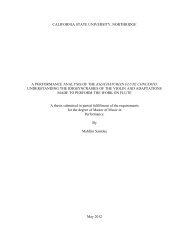Page 1 The California ""- Geographer Annual Publication of the ...
Page 1 The California ""- Geographer Annual Publication of the ...
Page 1 The California ""- Geographer Annual Publication of the ...
Create successful ePaper yourself
Turn your PDF publications into a flip-book with our unique Google optimized e-Paper software.
vanilla and coconUt products accounting for most <strong>of</strong> <strong>the</strong>m. Most important<br />
by far is cured vanilla. In 1961, 195 tons with a value <strong>of</strong> 175,914,000<br />
francs were shipped overseas. 3 Coconut products have been insignificant in<br />
recent years but as late as 1958 amounted to a value <strong>of</strong> 18,889,000 francs<br />
for unrefined coconut oil and 14,919,000 francs for shredded coconut.4<br />
Smaller amounts <strong>of</strong> coconut fiber, rum, and such tourist items as wood<br />
carvings, shell curios, baskets and hats were also sent abroad.<br />
Vanilla exports went to France, Germany, <strong>the</strong> United States and<br />
Australia, <strong>the</strong> coconut products and rum entirely to France, and <strong>the</strong><br />
souvenirs and curios to France, <strong>the</strong> United States, and New Caledonia.<br />
SrTE FACTORS<br />
Site factors influencing <strong>the</strong> immediate location <strong>of</strong> Tahiti's manufacturing<br />
concerns are generally simple and straightforward, again illustrating<br />
in most cases dependence on location near labor, power, raw material<br />
supply, or market. Nearly all <strong>of</strong> <strong>the</strong> establishments are in Papeete which<br />
represents <strong>the</strong> concent-ration <strong>of</strong> <strong>the</strong> market and <strong>of</strong> <strong>the</strong> labor supply, <strong>the</strong><br />
only source <strong>of</strong> power, and <strong>the</strong> entry port <strong>of</strong> <strong>the</strong> imported raw materials.<br />
<strong>The</strong> downtown section <strong>of</strong> Papeete consists <strong>of</strong> several blocks <strong>of</strong> two-storied<br />
frame buildings housing retail stores mingled with small carpenter shops,<br />
tins]11iths, matt-ress factories, and garment factories producing for sale<br />
both on and <strong>of</strong>f <strong>the</strong> premises, and invariably operated by Chinese who<br />
live on <strong>the</strong> floor above. Some <strong>of</strong> <strong>the</strong> larger bottling works and cement<br />
block manufacturers with greater space requirements are on <strong>the</strong> edge <strong>of</strong><br />
town but within range <strong>of</strong> electric power dist-ribution.<br />
<strong>The</strong> power plant itself lies near <strong>the</strong> waterfront adjoining <strong>the</strong> fuel oil<br />
storage tanks <strong>of</strong> <strong>the</strong> Phosphate Company. <strong>The</strong> ice plant is also on <strong>the</strong><br />
waterfront as it utilizes <strong>the</strong> freezer <strong>of</strong> <strong>the</strong> former fish cannery. Likewise<br />
<strong>the</strong> boat works obviously require waterfront location and are clustered<br />
around <strong>the</strong> north end <strong>of</strong> <strong>the</strong> harbor, removed from busy liner and schooner<br />
docks and yacht anchorages. (Figure 4)<br />
<strong>The</strong> two large processors <strong>of</strong> coconuts, both independent <strong>of</strong> city<br />
power, are located some miles from town in <strong>the</strong> midst <strong>of</strong> coconut producing<br />
areas. Vanilla curing is similarly located on <strong>the</strong> plantations.<br />
Most widespread are <strong>the</strong> many small units <strong>of</strong> <strong>the</strong> baking industry<br />
located throughout Papeete and in every village on <strong>the</strong> island-distributed<br />
as are <strong>the</strong>ir customers. <strong>The</strong> brewery adjoins <strong>the</strong> ca<strong>the</strong>dral, perhaps through<br />
some causal relationship that has escaped <strong>the</strong> author.<br />
Tahiti, <strong>the</strong> most Westernized <strong>of</strong> any <strong>of</strong> <strong>the</strong> South Sea islands <strong>of</strong><br />
Polynesia, has by far <strong>the</strong> greatest quantity and variety <strong>of</strong> manufacturing.<br />
In contrast, <strong>the</strong> people <strong>of</strong> Samoa, although three times as numerous, retain<br />
native culture to a greater degree and do not present a universal demand<br />
for Western foods, beverages, clothing and household goods, thus<br />
3 Pacific Islands Yem·bool� and Who's 'Vho, 9th ed., 1963, p. 157. <strong>The</strong> Pacific<br />
franc exchanges at 89.8 for $1.00.<br />
4 From data in Statistiques Douanidms, Annee Entiem 1958, Supplement au Jou1·<br />
, nal Ofliciel de la Polynesie Francaise du Avril 1959. In 1958 <strong>the</strong> Pacific franc exchanged<br />
at 63 for $1.00.<br />
26













